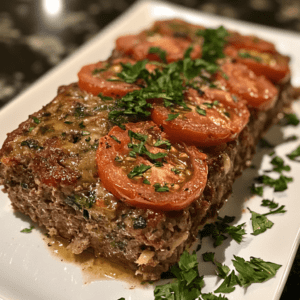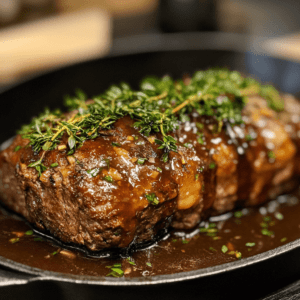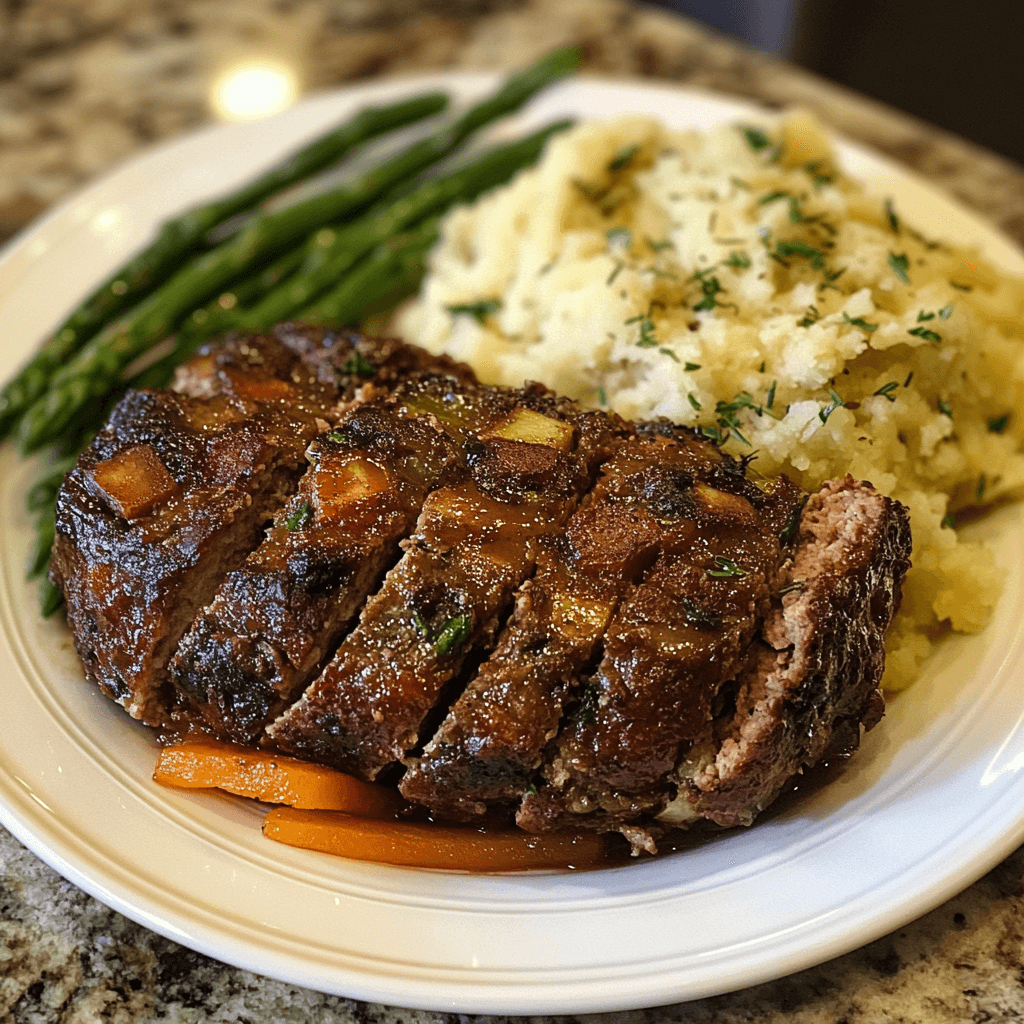Introduction
Meatloaf is a classic dish that has graced family dinner tables for generations. Its origins trace back to ancient times when people mixed ground meat with fillers to stretch limited resources. Today, it’s a beloved comfort food, offering a hearty, satisfying meal that’s both affordable and versatile.
What makes meatloaf so universally loved? It’s the simplicity of its ingredients paired with its ability to be customized. But while meatloaf is straightforward to prepare, achieving the perfect balance of flavor and juiciness can be tricky. That’s why uncovering the secret to juicy meatloaf is so important for home cooks striving for perfection.
The Science of Juiciness in Meatloaf
Meatloaf is a classic comfort dish that has graced dinner tables for generations. Achieving the perfect balance of flavor and juiciness is both an art and a science. Understanding the scientific principles behind a juicy meatloaf can help you elevate this humble dish to new culinary heights.


1. The Role of Fat
Fat as a Moisture Retainer
- Fat Content in Meat: Using ground meat with a higher fat percentage contributes significantly to juiciness. Fat melts during cooking, which bastes the meat from the inside.
- Types of Meat: Combining different meats like beef, pork, and veal can enhance flavor and moisture due to their varying fat contents.
2. Binding Agents and Fillers
Maintaining Structure and Moisture
- Eggs: Act as emulsifiers, helping to bind the meat and retain moisture.
- Breadcrumbs and Oats: These dry ingredients absorb and hold onto the juices released during cooking, preventing the meatloaf from becoming dry.
- Panade Creation: Mixing breadcrumbs with milk creates a panade, a paste that adds moisture and tenderness.
3. Incorporation of Vegetables
Adding Natural Juices
- Onions, Peppers, and Carrots: Finely chopped vegetables release water as they cook, adding to the overall juiciness.
- Mushrooms: Their high water content and umami flavor enhance both moisture and taste.
4. Mixing Techniques
Avoiding Overworking the Meat
- Gentle Mixing: Overmixing can lead to a dense, tough meatloaf. Mix ingredients until just combined to keep the texture light.
- Temperature of Ingredients: Keeping meat and other ingredients cold prevents fat from melting prematurely during mixing.
5. Cooking Methods
Optimizing Heat and Environment
- Temperature Control: Cooking at a moderate temperature (around 350°F or 175°C) ensures even cooking without drying out the exterior.
- Internal Temperature: Using a meat thermometer to cook until the internal temperature reaches 160°F (71°C) prevents overcooking.
- Resting Period: Allowing the meatloaf to rest after cooking redistributes the juices throughout the loaf.
6. Surface Treatments
Sealing in Juices
- Glazes and Sauces: Applying a glaze creates a barrier that locks in moisture and adds flavor.
- Bacon Wrapping: Wrapping the meatloaf in bacon adds extra fat and prevents the outer layer from drying out.
7. Cooking Vessels
Impact on Moisture Retention
- Loaf Pans vs. Free-Form: Cooking in a loaf pan allows the meat to cook in its own juices, while a free-form loaf allows excess fat to drain away. Choosing the right method affects juiciness.
- Water Bath: Placing a pan of water in the oven adds humidity, reducing moisture loss from the meatloaf.
Creating a juicy meatloaf is a delicate balance of ingredient selection, mixing techniques, and cooking methods. By understanding the scientific factors that contribute to moisture retention—such as fat content, binding agents, and cooking environment—you can craft a meatloaf that is tender, flavorful, and
Choosing the Right Meat
Selecting the appropriate meat is fundamental to achieving a juicy and flavorful meatloaf. The type of meat you choose influences not only the taste but also the texture and moisture content of the final dish.
1. Fat Content Matters
Balancing Flavor and Juiciness
- Ground Beef: Opt for ground beef with a higher fat content, such as 80/20 (80% lean meat to 20% fat). The fat renders during cooking, keeping the meatloaf moist.
- Avoid Very Lean Meats: Using meats like ground sirloin (90% lean) can result in a dry meatloaf due to insufficient fat.
2. Blending Different Meats
Enhancing Texture and Flavor
- Beef, Pork, and Veal Mix: A traditional meatloaf often combines these three meats. Beef provides robust flavor, pork adds sweetness and fat, and veal offers tenderness.
- Ground Pork: Adds extra fat and a subtle sweetness, contributing to moistness.
- Ground Turkey or Chicken: If using poultry, mix with fattier meats or add extra moisture through ingredients like vegetables or panade, as poultry is leaner.
3. Freshness and Quality
Impact on Taste and Safety
- Freshly Ground Meat: Fresh meat tends to have better flavor and texture. If possible, have your butcher grind the meat or grind it at home.
- Organic and Grass-Fed Options: These may offer superior flavor but can be leaner, so adjust other ingredients to maintain juiciness.
4. Considerations for Special Diets
Adjusting for Health Needs Without Sacrificing Moisture
- Lean Meats: If you prefer leaner meats for dietary reasons, compensate by adding extra moisture through vegetables, a panade, or healthy fats like olive oil.
- Plant-Based Alternatives: For vegetarian options, use plant-based ground meat substitutes that mimic the fat content of real meat, or incorporate legumes and mushrooms for texture and moisture.
5. Texture and Grind Size
Influencing Mouthfeel
- Coarse vs. Fine Grind: A coarser grind can provide a more robust texture, while a finer grind leads to a smoother meatloaf. Choose based on your preference.
- Uniformity: Ensure all meats are ground to a similar size for even cooking and consistent texture.
The Role of Binders
Binders are essential components in meatloaf that contribute to its structure, texture, and juiciness. They hold the meat mixture together, prevent it from crumbling, and help retain moisture during cooking.
1. Importance of Binders
Ensuring Structural Integrity and Moisture Retention
- Cohesion: Binders create a uniform mixture by holding together the ground meat and other ingredients, resulting in a meatloaf that slices neatly without falling apart.
- Texture Improvement: They contribute to a tender and moist texture by trapping juices within the loaf.
- Flavor Enhancement: Some binders add their own flavors or enhance the overall taste profile of the meatloaf.
2. Common Types of Binders
Traditional Ingredients That Bind and Moisturize
- Eggs:
- Emulsifying Properties: Eggs contain lecithin, an emulsifier that helps blend fats and liquids, creating a stable mixture.
- Protein Coagulation: When heated, egg proteins coagulate, providing firmness and structure.
- Breadcrumbs:
- Juice Absorption: Breadcrumbs soak up the juices released during cooking, preventing them from escaping and keeping the meatloaf moist.
- Texture Addition: They contribute to a lighter texture by creating small air pockets within the loaf.
- Oats:
- Moisture Retention: Oats absorb liquid and expand, helping to retain moisture.
- Nutritional Boost: They add fiber and nutrients without significantly altering taste.
- Crackers or Crushed Cereal:
- Flavor Variation: These can introduce different flavors or textures, such as a subtle sweetness or crunch.
3. The Panade Technique
Maximizing Moisture with a Bread and Liquid Mixture
- What is a Panade?
- A paste made by soaking breadcrumbs, bread pieces, or crackers in milk or another liquid.
- Function in Meatloaf:
- Tenderizing Effect: The panade keeps the meat proteins from shrinking and becoming tough by adding moisture and inhibiting over-coagulation.
- Flavor Carrier: It evenly distributes flavors from spices and seasonings throughout the meatloaf.
- Variations:
- Liquid Choices: Milk, cream, broth, or even tomato juice can be used to create different flavor profiles.
- Bread Types: Using different breads (white, whole wheat, sourdough) can subtly affect taste and texture.
4. Alternative and Dietary-Specific Binders
Adapting to Dietary Needs Without Sacrificing Quality
- Gluten-Free Options:
- Gluten-Free Breadcrumbs or Oats: Suitable for those with gluten intolerance or celiac disease.
- Cooked Rice or Quinoa: Adds unique textures and absorbs moisture effectively.
- Egg Substitutes:
- Flaxseed Meal: Mixing ground flaxseed with water creates a gel-like substance that can replace eggs.
- Chia Seeds: Similar to flaxseed, chia seeds absorb liquid and act as a binding agent.
- Vegetable Purees:
- Mashed Potatoes or Sweet Potatoes: Provide moisture and help bind ingredients together.
- Pureed Beans or Lentils: Increase protein content and aid in binding.
5. Balancing Binders with Meat
Finding the Right Proportions
- Avoid Overuse: Too many binders can lead to a dense or gummy texture.
- Consistency Check: The mixture should be moist but firm enough to hold its shape when formed.
- Even Distribution: Thoroughly mix binders with the meat and other ingredients to ensure uniformity.
6. Tips for Effective Use of Binders
Maximizing Their Benefits
- Soaking Dry Binders: Pre-soak breadcrumbs or oats in liquid to enhance moisture retention.
- Seasoning: Season binders separately to ensure they contribute to the overall flavor.
- Temperature Consideration: Keep ingredients cold to prevent premature fat melting, which can affect binding.
Incorporating Vegetables
Adding vegetables to your meatloaf is a fantastic way to enhance its flavor, moisture, and nutritional value. Vegetables contribute natural juices, introduce new textures, and infuse the dish with vitamins and minerals. Understanding how to effectively incorporate vegetables can transform your meatloaf from ordinary to extraordinary.
1. Benefits of Adding Vegetables
Enhancing Flavor, Moisture, and Nutrition
- Moisture Addition: Vegetables with high water content release juices during cooking, keeping the meatloaf moist and tender.
- Flavor Complexity: They introduce sweetness, earthiness, or a hint of spice, adding depth to the overall flavor profile.
- Nutritional Boost: Vegetables add essential nutrients like vitamins, minerals, and fiber, increasing the health benefits of the meatloaf.
2. Common Vegetables Used in Meatloaf
Varieties and Their Contributions
- Onions:
- Flavor: Provide sweetness and a savory depth.
- Moisture: High water content helps keep the meatloaf juicy.
- Garlic:
- Aromatics: Adds a pungent, savory note that enhances overall taste.
- Bell Peppers:
- Sweetness and Color: Introduce a mild sweetness and vibrant hues.
- Texture: Offer a slight crunch when not overcooked.
- Carrots:
- Natural Sweetness: Contribute subtle sweetness when finely grated.
- Nutrients: High in beta-carotene and fiber.
- Celery:
- Crunch and Freshness: Adds texture and a fresh flavor.
- Mushrooms:
- Umami Flavor: Enhance savory taste with their earthy notes.
- Moisture: High water content aids in juiciness.
- Zucchini:
- Moisture-Rich: Adds significant moisture without overpowering flavor.
- Texture: When grated, blends seamlessly into the meat mixture.
- Spinach:
- Nutrient-Dense: Provides iron, vitamins A and C.
- Color and Texture: Adds visual appeal and slight texture.
3. Preparation Techniques
Maximizing Flavor and Texture
- Chopping and Grating:
- Fine Dicing: Ensures even distribution and consistent texture.
- Grating: Ideal for hard vegetables like carrots and zucchini to blend smoothly.
- Sautéing Before Mixing:
- Flavor Development: Cooking vegetables like onions, garlic, and mushrooms enhances their flavors.
- Moisture Control: Reduces excess water that can make the meatloaf soggy.
- Raw Incorporation:
- Freshness: Preserves certain nutrients and textures.
- Convenience: Saves time without the need for pre-cooking.
4. Balancing Vegetable Quantities
Maintaining Meatloaf Structure
- Proportion Management:
- Optimal Ratio: Generally, use about 1 cup of vegetables per pound of meat.
- Avoid Overloading: Excess vegetables can cause the meatloaf to crumble or become too moist.
- Adjusting Binders:
- Compensation: If adding more vegetables, increase binders like eggs or breadcrumbs to maintain structure.
- Texture Consideration:
- Consistency Check: The mixture should hold together when formed into a loaf.
5. Enhancing Flavor with Vegetables
Adding Depth and Complexity
- Herbs and Spices:
- Fresh Herbs: Parsley, thyme, or cilantro can brighten flavors.
- Spices: Incorporate spices like cumin, paprika, or chili flakes for warmth.
- Roasted Vegetables:
- Intensity: Roasting concentrates flavors of vegetables like bell peppers and garlic.
- Sweetness: Caramelization adds a natural sweetness.
- Vegetable Purees:
- Smooth Texture: Pureeing vegetables like onions or mushrooms can integrate flavors seamlessly.
- Moisture Addition: Purees contribute to juiciness without altering texture significantly.
6. Nutritional Advantages
Boosting Health Benefits
- Fiber Increase: Vegetables add dietary fiber, aiding digestion.
- Vitamin and Mineral Enrichment: Adds essential nutrients like vitamin C, potassium, and antioxidants.
- Calorie Management: Vegetables can bulk up the meatloaf, allowing for a larger portion size without significantly increasing calorie content.
7. Catering to Dietary Preferences
Adaptations and Substitutions
- Vegetarian Options:
- Meat Substitutes: Use lentils, beans, or tofu combined with vegetables for a meatless loaf.
- Binder Adjustments: Utilize eggs, flaxseed meal, or breadcrumbs to bind non-meat ingredients.
- Gluten-Free Variations:
- Alternative Binders: Use gluten-free oats or rice in place of breadcrumbs.
- Vegetable-Based Fillers: Increase vegetable content to replace some of the meat volume.
8. Tips for Successful Vegetable Integration
Best Practices for Optimal Results
- Seasoning:
- Layering Flavors: Season vegetables during sautéing to build depth.
- Moisture Control:
- Draining Excess Liquid: For watery vegetables like zucchini, squeeze out moisture after grating.
- Uniform Cooking:
- Even Sizes: Cut vegetables uniformly to ensure they cook evenly within the meatloaf.
- Experimentation:
- Flavor Profiles: Try different vegetable combinations to create unique tastes.
- Cultural Twists: Incorporate vegetables common in different cuisines, like corn and black beans for a Southwestern flair.
Moisture-Enhancing Additives
Enhancing moisture doesn’t stop at vegetables. Consider these additives:
- Dairy Products: Adding milk, cream, or yogurt softens the meatloaf and keeps it moist.
- Broths and Stocks: Incorporating beef or chicken stock boosts both moisture and flavor.
These ingredients act as insurance against dryness, ensuring every bite is juicy.
The Power of Seasonings and Spices
A bland meatloaf is a missed opportunity. Seasonings not only enhance flavor but also complement the moisture:
- Balancing Flavors: Use salt, pepper, garlic, and onion powder as a base, then experiment with herbs like parsley or thyme.
- Umami Boosters: Add soy sauce, Worcestershire sauce, or even grated parmesan for depth of flavor.
When seasoned properly, the meatloaf’s juices carry a burst of flavor in every bite.
The Perfect Mixing Technique
Overmixing can make meatloaf dense and dry. Here’s how to avoid that:
- Gentle Mixing: Use your hands or a fork to combine ingredients without compacting the meat.
- Even Distribution: Ensure binders, seasonings, and vegetables are evenly incorporated for consistent texture.
Proper mixing ensures a light, tender meatloaf that holds its shape.
Forming the Meatloaf
The shape and size of your meatloaf affect its cooking time and moisture:
- Shape Matters: A flatter loaf cooks faster, reducing the risk of dryness.
- Uniform Thickness: Ensures even cooking throughout.
Avoid tightly packing the meat mixture, as this can lead to a dense and dry texture.
Cooking Methods for Juicy Meatloaf
How you cook your meatloaf is as important as what you put in it:
- Oven-Baked: A tried-and-true method that ensures even cooking. Bake at 350°F for optimal results.
- Water Bath: Placing the loaf pan in a water bath prevents the edges from drying out.
- Alternative Methods: Instant Pots and air fryers can also yield juicy results if used correctly.
Monitor your meatloaf’s internal temperature—it should reach 160°F for safe consumption without overcooking.
The Importance of Toppings and Glazes
A good glaze seals in moisture while adding flavor:
- Popular Glazes: Ketchup, BBQ sauce, or a mix of brown sugar and mustard.
- Application Tips: Apply glaze during the last 15 minutes of cooking to prevent burning.
Experiment with toppings to find your perfect flavor profile.
Resting Your Meatloaf
Allowing your meatloaf to rest after cooking is a critical step:
- Why It Matters: Resting allows juices to redistribute, making every slice moist.
- Resting Tips: Cover loosely with foil for 10-15 minutes before slicing.
Skipping this step can result in juices escaping, leaving your meatloaf dry.
Common Mistakes to Avoid
Avoid these pitfalls to ensure juicy meatloaf success:
- Overcooking: Use a thermometer to prevent drying out.
- Skipping Fat: Don’t sacrifice flavor by choosing overly lean meats.
- Rushing: Allow time for resting and careful mixing.
Learning from these mistakes ensures a foolproof recipe every time.
Top Meatloaf Mistakes and How to Avoid Them
- Safe Cooking Temperatures
- In the section discussing internal meatloaf temperatures, link to the USDA’s food safety guide:
Example:
“Ensure your meatloaf reaches a safe internal temperature of 160°F as recommended by the USDA Safe Cooking Temperatures Guide.”
- In the section discussing internal meatloaf temperatures, link to the USDA’s food safety guide:
- Moisture-Retaining Ingredients
- When talking about the importance of binders and vegetables, link to a relevant article or ingredient guide:
Example:
“For more tips on using vegetables to retain moisture, check out this guide from Bon Appétit.”
- When talking about the importance of binders and vegetables, link to a relevant article or ingredient guide:
- Creative Meatloaf Recipes
- For readers interested in exploring more meatloaf variations, link to a trusted recipe site:
Example:
“Experiment with creative ideas from Food Network Meatloaf Recipes.”
- For readers interested in exploring more meatloaf variations, link to a trusted recipe site:
- Cooking Techniques
- For advanced cooking methods like using an air fryer or Instant Pot, link to an external tutorial:
Example:
“Learn how to make meatloaf in an Instant Pot with this detailed guide from AllRecipes.”
- For advanced cooking methods like using an air fryer or Instant Pot, link to an external tutorial:
- Meat Selection
- When discussing different types of meat, link to a resource on meat blends:
Example:
“Explore the best ground meat combinations for meatloaf in this article by Serious Eats.”
- When discussing different types of meat, link to a resource on meat blends:
FAQs About Juicy Meatloaf
- What is the secret to juicy meatloaf?
The secret lies in balancing fat content, using binders, and incorporating moisture-enhancing ingredients like vegetables and broths. - Can I use lean meat and still have a juicy meatloaf?
Yes, but you’ll need to add extra fat or moisture through dairy, broth, or vegetables. - How long should I cook meatloaf to keep it juicy?
Bake at 350°F until the internal temperature reaches 160°F, typically 1–1.5 hours. - Do I have to use breadcrumbs?
No, alternatives like oatmeal or crushed crackers work well. - How can I make my meatloaf flavorful and moist?
Use a combination of fat, seasonings, vegetables, and a flavorful glaze. - What toppings work best for juicy meatloaf?
Ketchup-based glazes, BBQ sauce, or mustard-sugar blends are great choices.
Conclusion
Creating a juicy meatloaf is an art that combines the right ingredients, techniques, and care. By choosing high-fat meats, incorporating moisture-rich ingredients, and cooking with precision, you’ll master the secret to juicy meatloaf every time. Don’t be afraid to experiment and make it your own. Enjoy this timeless comfort food with family and friends!
Related article:

